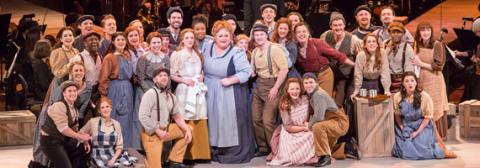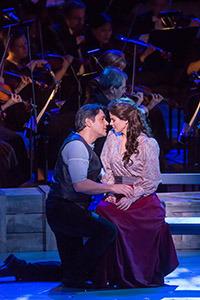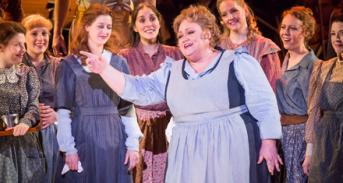
Cast of Carousel, with Stephanie Blythe (center)
According to Kander and Ebb, life is a cabaret. But with Rodgers and Hammerstein, it’s a lot closer to a carousel: life goes round and round and round, but where it stops… nobody truly knows. We do know one thing, though: musical theater hasn’t been the same since.
Their classic Carousel was the closest Richard Rodgers and Oscar Hammerstein II ever came to an actual opera. Jerome Kern’s Show Boat, with book and lyrics by a young Hammerstein, and Rodgers and Hammerstein’s initial collaboration, the groundbreaking Oklahoma! , were its models and predecessors, but Carousel was the show that paved the way toward a fuller, more complete unification of words, music, dance, scenic and story elements.
In all three of these works there is constant orchestral underscoring, as well as singing in a most lyrical vein. With Carousel, however, we are witnesses to that point of departure where musical “comedy” ends and musical “theater” – our modern-day musical theater – takes off and begins to make huge strides in a way not seen in 1945, the year of the show’s debut.
The Live from Lincoln Center presentation of Carousel, broadcast by PBS on Friday, April 26, 2013, brought these undercurrents to the fore. This was a fully realized concert performance of the work, with the famed New York Philharmonic on stage throughout in superb fashion. There is nothing like hearing a full symphony orchestra at work in this gorgeous, melodious, and supremely sophisticated score. As such, Carousel is no ordinary musical, nor does it have an ordinary plot line, either. There are real world concerns at play: wife beating, domestic violence, unemployment, premeditated murder, robbery, attempted rape, even prostitution and promiscuity, not frivolous operetta subjects such as merry widows or eccentric counts. This is what might be called “serious” musical theater, and the production and acting reflected it.
Based on Ferenc Molnár’s 1908 play Liliom, this revival featured a powerhouse cast headed by Nathan Gunn as carnival barker Billy Bigelow, Kelli O’Hara as mill worker Julie Jordan, Jessie Mueller as Julie’s best friend Carrie Pipperidge, Jason Daniely as her ambitious fiancé and fisherman Enoch Snow, Stephanie Blythe as Julie’s loving cousin Nettie, Shuler Hensley as the slimy Jigger Craigpin (what a name for a bad guy!), and stage veteran John Collum in the dual role of The Starkeeper and Dr. Seldon. The New York Philharmonic was led by Rob Fisher, whose previous credits include a semi-staged concert version of Sweeney Todd. The Act II ballet sequence was performed by dancer Tilar Peck, as Billy’s daughter Louise, and Robert Fairchild, both of the New York City Ballet.
Carousel’s overture starts off with some mournful low notes in the brass, which quickly give way to the buoyant carousel theme. The prominence of strings, wind instruments and tuba give this jarring piece the feeling of spinning around in circles, of a rollicking good time before the fun ends (and reality sets in). A short while later, the beautiful “If I Loved You” is heard. This number, a masterpiece of musical subtlety, helps to introduce the main characters. The duet, or should I say a compilation of various solo pieces, is so well integrated into Rodgers’ musical fabric that these individual airs blend seamlessly into one another, while the main “If I Loved You” theme acts as a recurring motif for the remainder of the show.

Nathan Gunn & Kelli O’Hara in Carousel
Here’s where the likable Miss Julie Jordan meets the shady Mr. Billy Bigelow, two of the most beloved characters in musical theater history. They recount their separate stories to each other, or as much of their stories as they wish to tell one another at that moment. The possibility of a future life together are divulged not only for the audience’s benefit but for theirs as well, each conveying to the other how much they love, may love, don’t love, but could love the other (their snappy repartee would give shrinks nightmares). Rodgers and Hammerstein achieved an unprecedented fusion of dialog with brief extracts of musical notations in this, their most understated work. Billy and Julie trade “punches,” musically speaking, to be replaced with physical punches of abuse later on (this is no ordinary 1940s couple, that’s for certain). Their reverie concludes with a passionate kiss and marriage – not one made in heaven mind you, as we shall see.
Waltz tunes appear throughout, and derive from Viennese operetta (the second-act opener “A Real Nice Clambake” is a perfect example), surely an Oscar Hammerstein holdover from Show Boat — the very model of a modern American operetta. Other numbers skillfully juxtapose newly-wedded bliss (the courtship of Julie’s friend, Carrie, and the pompous Mr. Snow), with the unpleasantness of Billy and Julie’s married life: trust, faith and interdependency are replaced by anger, disillusion and disappointment. As American a theater piece as Our Town or Porgy and Bess, Carousel invokes an ennobling sense of community, of belonging to a wider and deeper whole; of being alive and being active, of participating in life’s labors, of living, loving, marrying, giving birth, and dying – the cycle repeating itself in diverse ways, in particular with Billy returning to earth to see and touch and speak to his estranged daughter Louise, who never got to know her father while he was alive.
A Worthy Revival
I found this Lincoln Center revival of Carousel to be an extraordinary musical experience, with so many wonderful numbers flowing one after another: “When I Marry Mr. Snow,” “What’s the Use of Wondr’in,” “June is Bustin’ Out All Over,” “When the Children Are Asleep,” “You’ll Never Walk Alone,” and, of course, “Soliloquy” – the most famous and, it turns out, most witty, most elaborate, and most technically advanced showstopper ever written for the musical stage; that is, before the advent of Stephen Sondheim and his psychologically penetrating oeuvre.
To me, John Raitt, the original Billy Bigelow, and (in film and recordings) the irreplaceable Gordon MacRae, are the perfect embodiment of this problematic, difficult to admire character. The scene of Billy’s suicide still brings a lump to one’s throat and is the emotional highpoint of the drama, even 60 years after the show’s premiere. How could its creators have killed off their lead character? Well, they did, and the show has gone on to triumph night after night ever since. Baritone Nathan Gunn as Billy came close to achieving perfection in this scene, and in this part, although the role’s tessitura is a shade high for him. Most lyric singers can manage it, however, and Gunn earned kudos for having given it his all. Frank Sinatra, who was supposed to have starred in the 20th Century-Fox film adaptation with Shirley Jones, never could master the role’s complexity or find the crux of the character’s soul. Thankfully, he was replaced by MacRae. Here, Gunn was especially moving, showing off Billy’s carnival-barker swagger to good effect, in addition to his not-so-well disguised vulnerability, a tough feat to accomplish.

Stephanie Blythe as Nettie
Kelli O’Hara as the sweetly unassuming Julie Jordan was so pleasant, so charming, and so thoroughly captivating (but not in a mawkish way), what man in his right mind could resist marrying such a girl? It helped that her singing was of the highest order, which gave her numbers added sparkle and warmth – a heartfelt, lovely performance. Mezzo Stephanie Blythe as Nettie dominated with her every appearance, with that tremendous vocal apparatus and skillful stage deportment of hers. Who said size doesn’t matter? And she employed that sizable contralto wisely in the potently hymn-like “You’ll Never Walk Alone,” as powerful a tune as Rodgers and Hammerstein could conjure up. It’s resemblance to “Climb Every Mountain” from The Sound of Music, and the fact that another contralto role, that of the Mother Superior, was entrusted to deliver it, makes me want to wait for Blythe’s next musical assignment with baited breath!
Jessie Mueller’s Carrie and Jason Daniely’s Mr. Snow complemented each other beautifully: she, simple, plain-spoken, and down-to-earth; he, whiny, self-centered, and full of money-making schemes. John Collum nearly stole the show with his brief albeit crusty incarnations. Shuler Hensley as Jigger used his height and bulk to advantage in creating a contrasting foil for Billy. How this villainous character reminds me of Judd Fry, minus that fellow’s less frequently performed “Lonely Room.” In fact, all of Carrie and Snow’s numbers are so like Laurey and Curly’s duets from Oklahoma! It’s as if Rodgers and Hammerstein were giving all the best songs to the secondary couple (not so, of course, but that’s the impression – more examples of the growing importance of secondary characters to a musical’s plot).
With that, Carousel can be called one hundred percent musical theater, the kind that leaves most of what we know as musical theater far, far behind. The enthusiastic reception it received at Avery Fisher Hall was ample evidence of how this show still has an effect on people: its truths about the human experience, the elevation of the working stiff (a.k.a. the common man) to the status of saints, mark this work as from another period entirely – i.e., the proletarian dramas of the Depression Era 1930s. The Protestant work ethic is made evident, along with sympathy for the downtrodden among us, for those unsung heroes of labor, the fishermen, the dock workers ,the servants, the working-class citizen and the like, no doubt an Oscar Hammerstein concern, which first appeared in his book for Show Boat, based on a novel by Edna Ferber.
These same social concerns showed up in Oklahoma!, South Pacific, and Flower Drum Song, and continued on in the stellar work of Frank Loesser with Guys and Dolls, The Most Happy Fella, and How to Succeed in Business Without Really Trying, the ultimate lazy man’s guide to making it in the corporate workplace; with Lerner and Loewe’s My Fair Lady; with Jule Styne and Stephen Sondheim’s Gypsy; with Cy Coleman and Dorothy Fields’ Sweet Charity; and with Richard Adler and Jerry Ross’ The Pajama Game. They even turned up (to a point) in Stephen Sondheim and Hugh Wheeler’s Sweeney Todd, with working class anxieties spilling over into an industrialized England (“But there’s no place like London”), where a warped sense of honor and revenge give way to murderous intent and the obsessively pathological.
Still, a good musical will always outshine the competition. It will always be a good musical, whether it’s revived or not. But a truly great musical, with classic show tunes, is not only revived; it can beget other great musicals. In Rodgers and Hammerstein’s case, Oklahoma! begat Carousel, their greatest musical achievement ever which begat the above named stream of shows – which then became a roaring river of hits. What better proof is there of the genre’s continuing relevance and influence than this latest revival?
The secret to Carousel’s success, and its enduring popularity among musical theater connoisseurs, is its fondness for simple truths. So continue to hold your chin up high, Carousel. And don’t be afraid of the dark. Walk on, with hope in your heart. For as a musical, you’ll never walk alone.
Copyright © 2013 by Josmar F. Lopes

